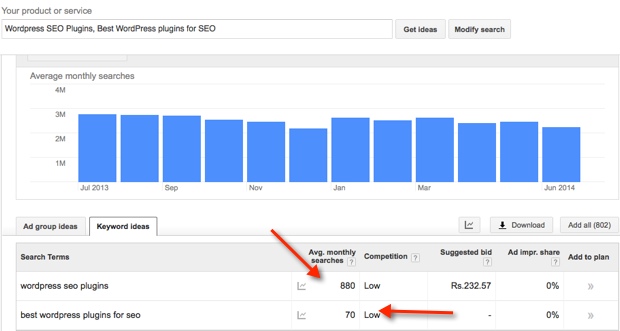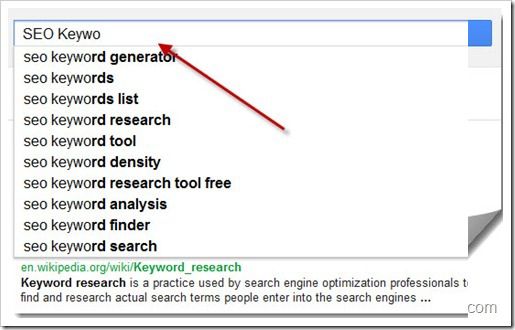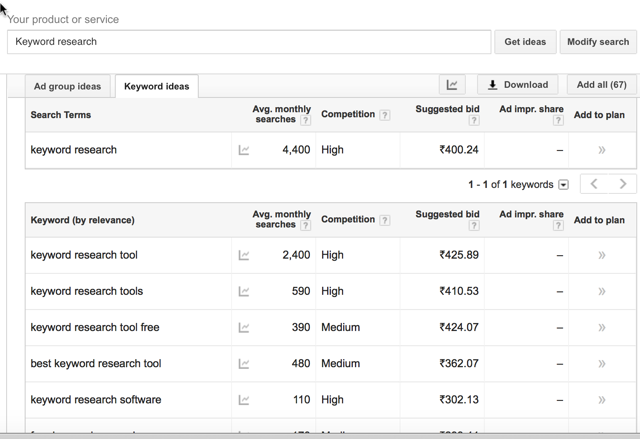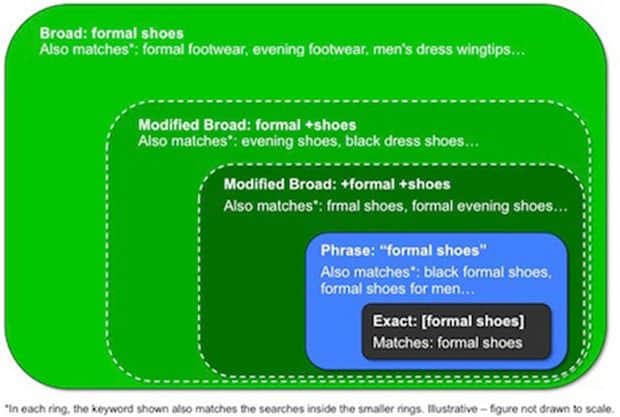Google doesn’t know you or hate you! If you are writing & not ranking on the first page of search engine, that means you are doing something wrong.
Take 10 second break & ask yourself:
How does search engine rank a web-page? Is in’t it few lines or codes which automatically decide which page should be on the first page of search engine.
Well, search engine looks for signals to rank a page & it’s easy for you & me to tweak our article & give all those signals to search engine & enjoy all the traffic.
In order to get to that point, you need to start from here & let’s begin:
Keyword research is one topic, which every blogger should learn from day one. Probably, every Blogging or SEO blog you have read till now, I’m sure Google Keyword Planner (previously Keyword Tool) and “Keyword research” are not a new term for you. But if not, you are missing out the basic of any Blog SEO.
Blogging has evolved from just quality content to SEO optimized social content. Writing quality content is a must, but at the same time, it’s good to have the properly optimized article to rank well in search engines. This is where on page SEO comes into the picture. On the page, SEO starts with selecting the right keyword for your post, and the keyword should be one which have search volume. That means people are searching for that particular keyword.
Here is one question you should ask yourself: Even though I’m writing quality content, why I’m unable to drive enough traffic from search engine? Well, I’m sure Google doesn’t have anything against you until unless you are doing Black Hat SEO. The reason is, you are not writing on topics that people are searching for. Or even you are writing on a topic that is trending, but you are making it hard for search engine bots to understand your content. I have already covered how to write SEO optimized articles in WordPress, and today you will learn how to use Keyword Planner tool for researching Keyword.
What is Keyword research?
Let’s get to know the basics first. In layman language, Keyword research is the process of identifying Keywords, which get the good amount of search volume/month. For example, Keyword: “KeywordSpy”, “Website SEO optimization tip” and so on. The idea behind performing a research is to, find the keywords that can give maximum traffic and comes with less competition. I will discuss competition part later in this post. For example: When you do an exact match search: “WordPress SEO plugins”, “Best WordPress Plugins for SEO ” both gives the entirely different picture in terms of traffic.

By doing a complete Keyword search, you will be able to find keywords to drive targeted traffic, more revenue and more niche traffic. Moreover, when you are planning to target a small niche, for example, “Bug Spray”, doing a Keyword search will help you to find many new Keywords that you might be missing out. You can also analyze competitor site and find keywords which they were ranking for. Doing a comprehensive Keyword research based on the data can drive immense traffic to your site. And by the end, the sale happens only when you are getting targeted traffic. Isn’t it?
What is Google Keyword Planner tool:
Google Keyword tool is an official product from Google, which gives us a traffic estimation of our target Keywords and also help in finding more relevant and related Keywords for your niche. Few Important things to know:
This is what the homepage of Keyword Planner tool looks like. All you need to do is enter your target Keyword that you want to start searching for. After that, you can add filters such as for which country you want to target your keywords (In below example, All location is selected).

1) Enter your product or services:
This is the place where you will put your target Keywords. For example, my next post in on Keyword research, and I’m not sure what keyword I should be targeting that post for, I will do some searches based on my knowledge like you see in the example, and it shows me results globally and local search. The idea here is to find a Keyword that has good traffic but low competition. If you are working on a blog for the long-term goal, you can also target high competition Keyword, using resource pages. For ex: WordPress guide. It makes take time before you see your keyword ranking at the good position. Below image illustrates the difference between Broad search, Exact search and phrase search.
2) Search type:
This is one important column that you should be taking care of. There are three options for search type:
Exact Match: Exact searches, shows the traffic for exact match Keyword. For example, if you search for WordPress SEO in exact match, it will be different from broad search in a great way. My suggestion, prefer Exact search when you are doing research for your micro-niche site and broad search when you are writing on the personal blog. Ex: Keyword Research Broad Match: Broad Match is my favorite, as it let me target long-tail keyword, and your traffic is not limited to exact match words. For Bloggers, broad match is useful, but that again depends on your blog type and target. Ex: “Keyword-based research” Phrase: Phrase type is useful when you need Keyword in an exact phrase. For example: “Best Keyword Research”. Keyword position won’t be changing, but it gives the data for traffic, that your Keyword might be getting for phrase search.
3) Advanced option and filter:
This feature is set to add more filters to your search. For example Country search volume, Language and target device (Computer or mobile devices). Depending upon your target audience, you can set everything including the category.
4) Understand Keyword tool column:
Notice the pointer 4 in the above image and now, understand the meaning of each column.
For this tutorial, let’s keep it simple and let’s keep our example for broad search type.
Performing Keyword research using Google Keyword tool:
I hope this must have given you a basic understanding of Keyword tool by Google works, and now, we will move to real deal here. Our target is to find some low competitive but high-medium traffic Keyword using Google search, Google Keyword research tool, SEMRUSH & LongTailPro.
We will be using SEMRUSH or LongTailPro to analyze the competition of a keyword. Basically, this would help us determine how easy or difficult it is to rank for a certain keyword.
Now, before we start here is a quick question:
What one of these is better?
Getting 100 untargeted visitors or 10 targeted one?
If your answer is “Targeted”, then don’t leave those keywords with low traffic. Since it’s relevant to your niche, in longer run it will help you. Make sure to check “Google traffic trend” too, which will help you to check your target keyword traffic pattern over the time.
Discover Keyword using Google Instant search:
Google instant search is my first basis of finding a perfect Keyword. It’s more like a Keyword discovery tool, which you can use to generate tons of ideas. Though you can’t use all of them, but for initial step, it’s good to brainstorm some ideas for K/w research. Put any Keyword related to your niche, for example; I started typing “SEO Keywo” and Google Instant search suggested search results. Depending upon your post type, you can pick a couple of them which make sense to you. Look at this screenshot:

Once you have found 3-4 such Keywords, start adding it to Google Keyword suggestion tool and perform a search. So I picked two keywords from the list: “SEO Keyword Search” & “SEO keyword research” as both are similar and make sense for my niche, and I can come up with a post on that. Now next step is to find if these two Keywords are going to do any benefit regarding traffic, or just going to be another article with not much value from traffic POV.
Let’s move on to the next step:
Keyword search analysis:
Now, I will put both the Keywords in search tool and perform a search, it will give me details for search type I’m performing and also show relevant Keyword ideas. Now, that is keyword goldmine for you, as it will let you find many relevant Keywords that you can target in the same post or else can come up with a follow-up post.

I usually target 2-3 Keywords/post. You can create your SEO strategy depending upon your post quality and length. So, for the information sake, we have selected only Two keywords as shown in above picture, and it’s time to check, which one of them is less competitive. Before that, you can change your filter to see if your target Keyword has any exact match type or not.
Checking Keyword competition using SEMRUSH:
Once you have identified the keyword, next thing is to check the keyword competition, or you can call it ‘Keyword difficulty.’ This is just to measure how difficult it is to rank for a certain keyword.
Note: If you are creating an authority micro niche site, you should target all possible keyword, despite difficulty level.
I usually use SEMRUSH for checking the keyword competition & it is also handy to find related keywords that I usually place around the post. Let me explain what I meant by an example.
I searched for a Keyword “SEO Keywords” in SEMRUSH tool & this is the result that I got.

In the above screenshot, you can see Keyword with their variation along with volume. On the right-hand side, you can see the related Keywords which is not so different, but it varies a lot when you are researching keyword for the different niche.
Note: Do pay attention to Column call CPC. This is useful for anyone who is using AdSense to make money from their blog. The higher the CPC for any keyword is & if you rank higher in search engine for that keyword, you are more likely to earn huge/click from Adsense. I have talked about this in detail here.
Back to the above screenshot, clicking on view full reports would show detailed information about all keywords. First, have a clear look at the below screenshot:

I have highlighted Keyword competition column with the red box. Though; this detail is for advertisers, but it would give you a good idea of what Keyword you should target.As you can see here, according to competition checker tool, “meta keywords SEO” is easier to rank.
If you are looking something from a blogger/publisher point of view to rank a post, then use LongTailPro.
Download LongtailPro (Windows & Mac only) (Windows & Mac only)
LongTailPro shows competition based on factors such as domain age, the number of backlinks, on Page SEO, page rank, DMOZ submissions, Domain authority& few other significant factors. You can also click on “view details” to see more detailed results for your competitor. Here is a detailed competition report for my target Keyword: (For first top 10 results)
Do remember when writing an article or making a post keyword targeted, you need to have Keywords in your Title, description, and H1 tag. Take care of keyword density, LSI keyword, add videos & few other signals. We have discussed this in-depth over here.
Along with above-mentioned points, backlink and social media promotion are one major factor for better ranking. Also, my suggestion for you is always to ensure you domain expiry date is not before next three years.
What next?
So now, we have one keyword with us, and similarly, you can find many keywords related to your niche. It might be the little time-consuming, but it’s worth more than spending un-targeted ten posts. Now, your next target should be writing a Keyword optimize article (SEO copy-writing), and you can refer to our earlier guide on OnPage optimization.
Never forget, this Keyword research is just a primary steps, and real magic starts with your content. Moreover, never try to get traffic on the wrong keyword, as it will affect your overall blog performance regarding Avg. Time on site and bounce rate. For your old blog articles, if you have not optimized them for any Keyword, you can use Google analytic data, any software for
For your old blog articles, if you have not optimized them for any Keyword, you can use Google analytic data, any software for Keyword research and work on re-optimization for Keyword. I did this for almost 30% of my old posts, and they started ranking in 1-2 page in ranking.
Postcredits: shoutmeloud


READ HERE-: HOW TO CREATE MICRO NICHE BLOG AND EARN 500$ IN A MONTH TRICKS
ReplyDelete